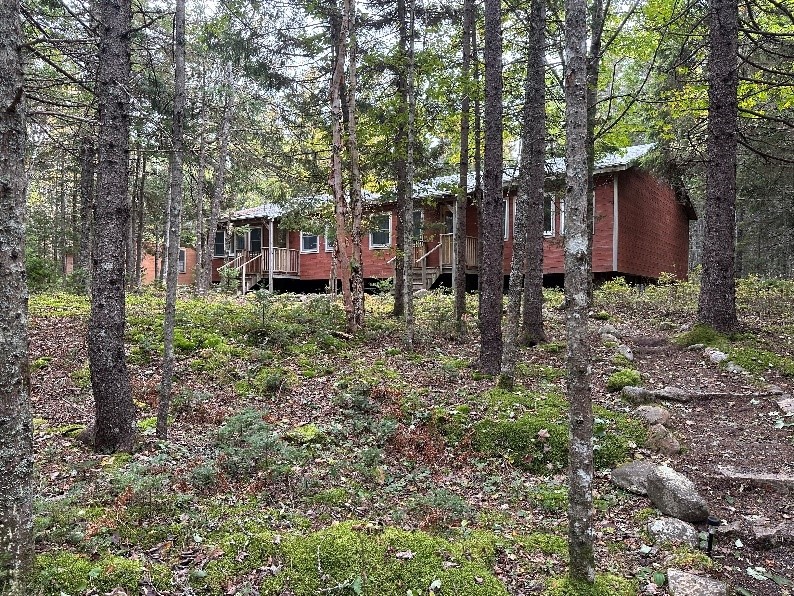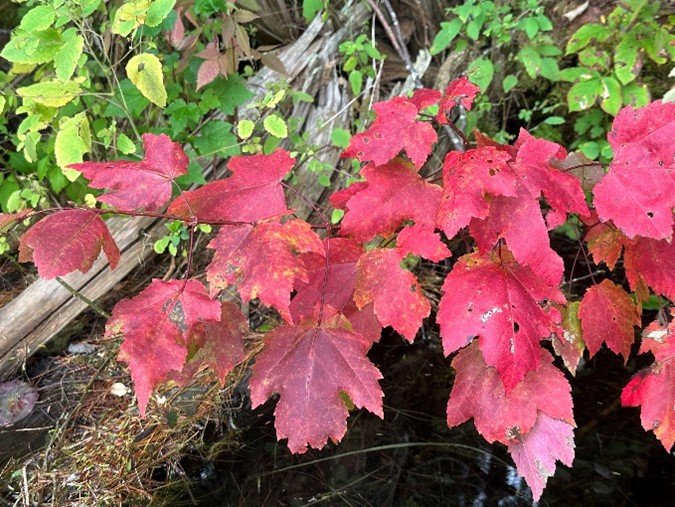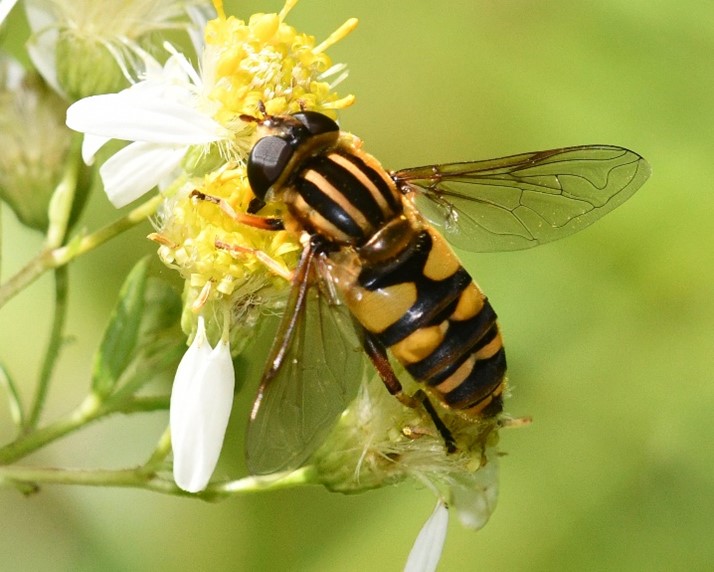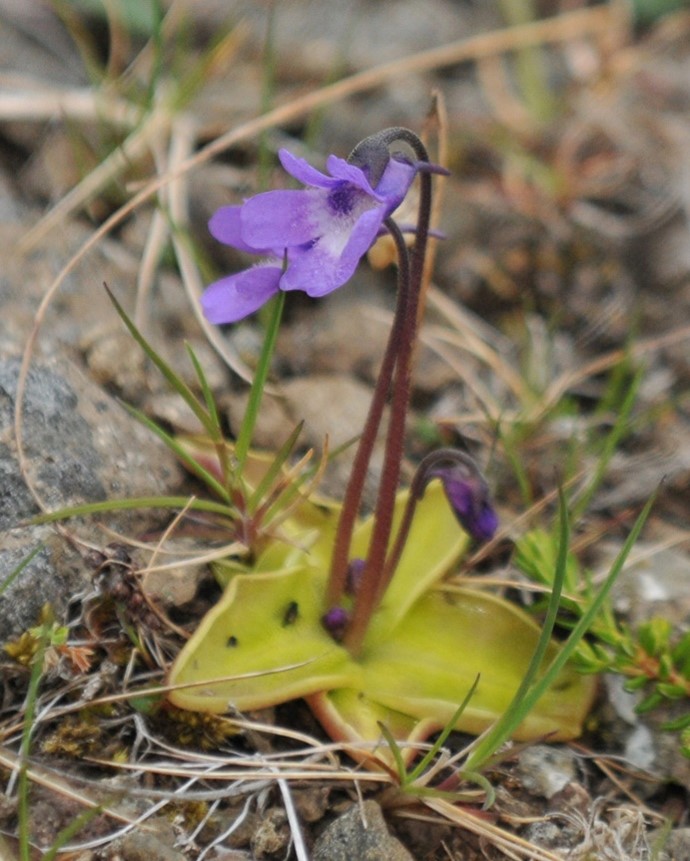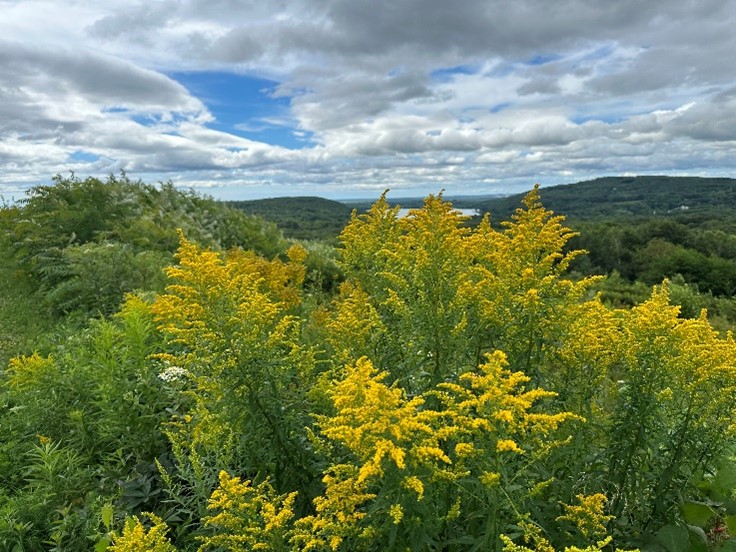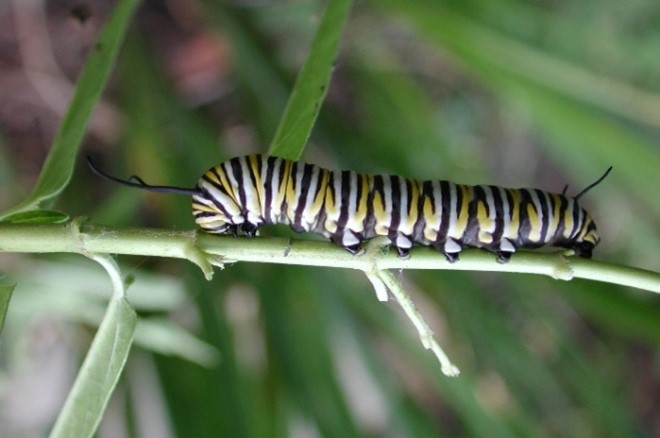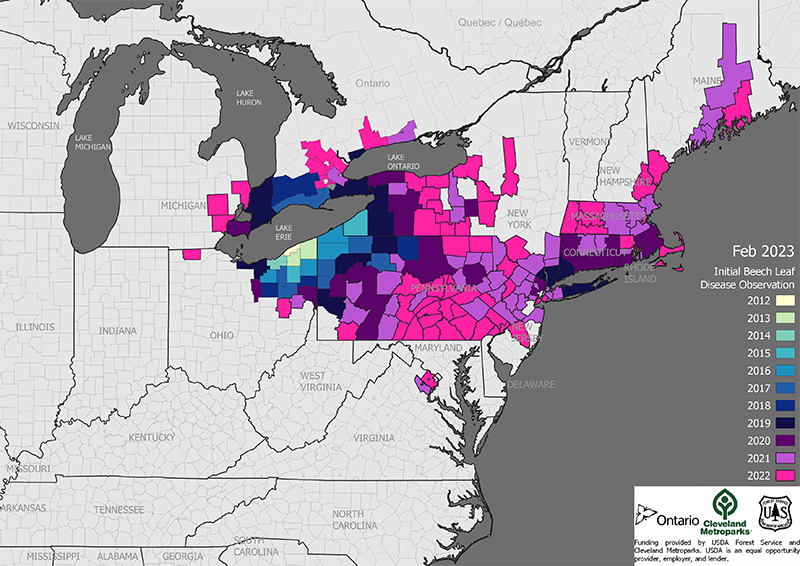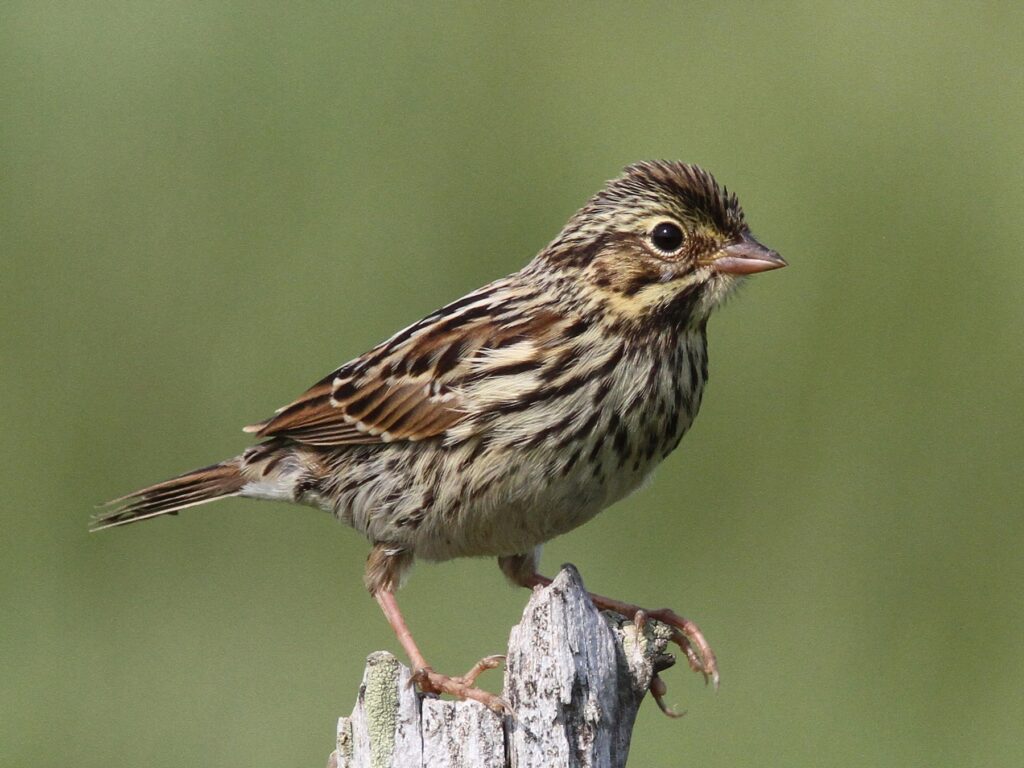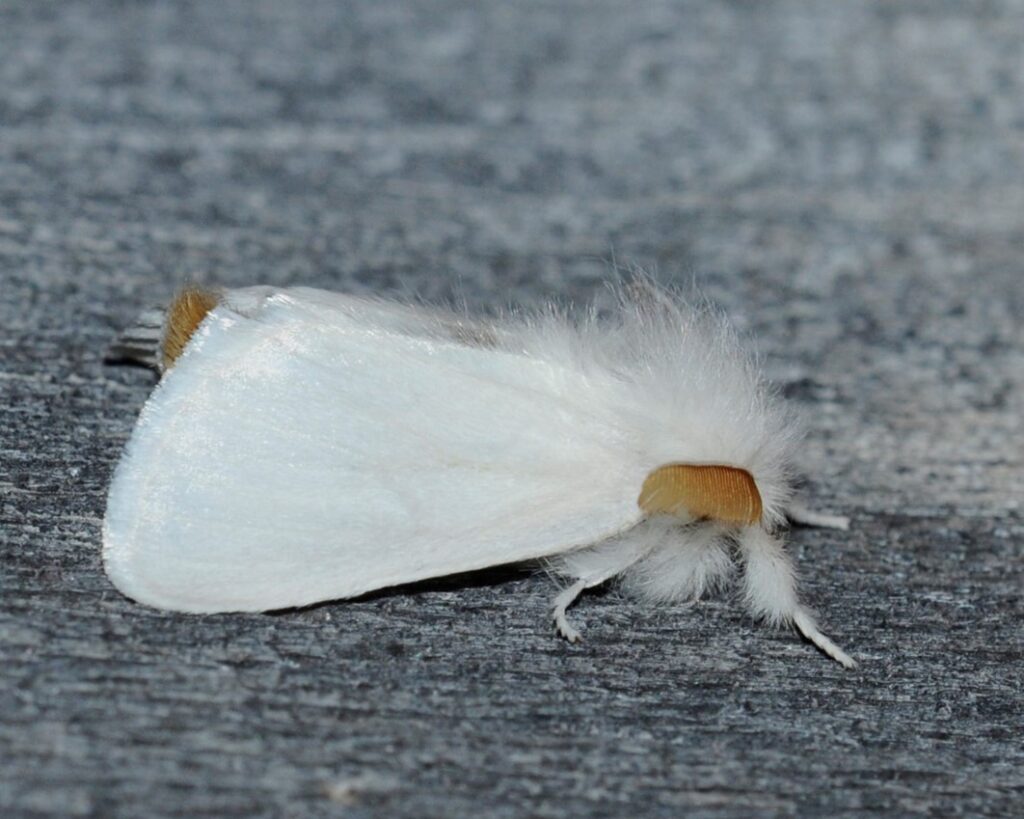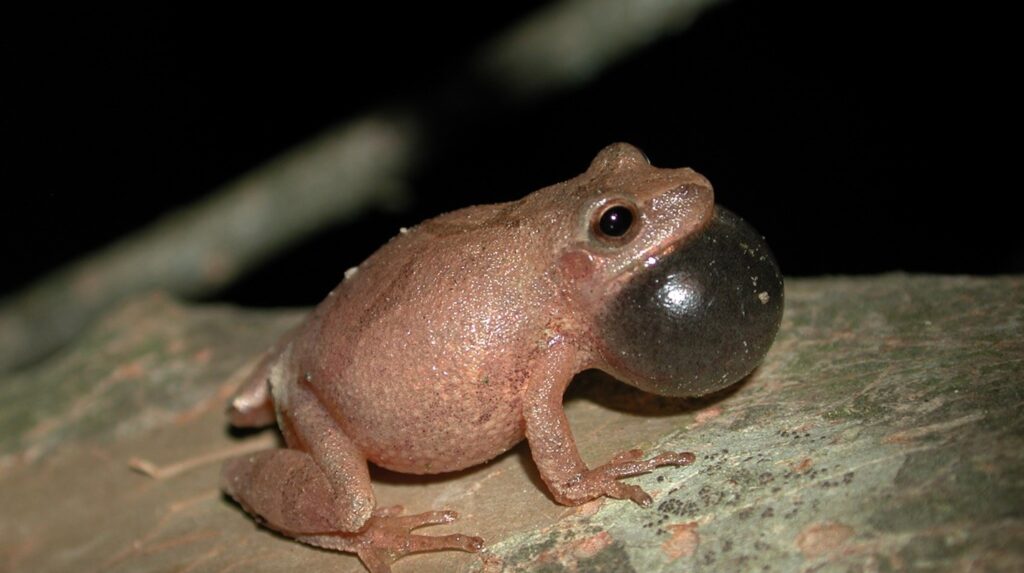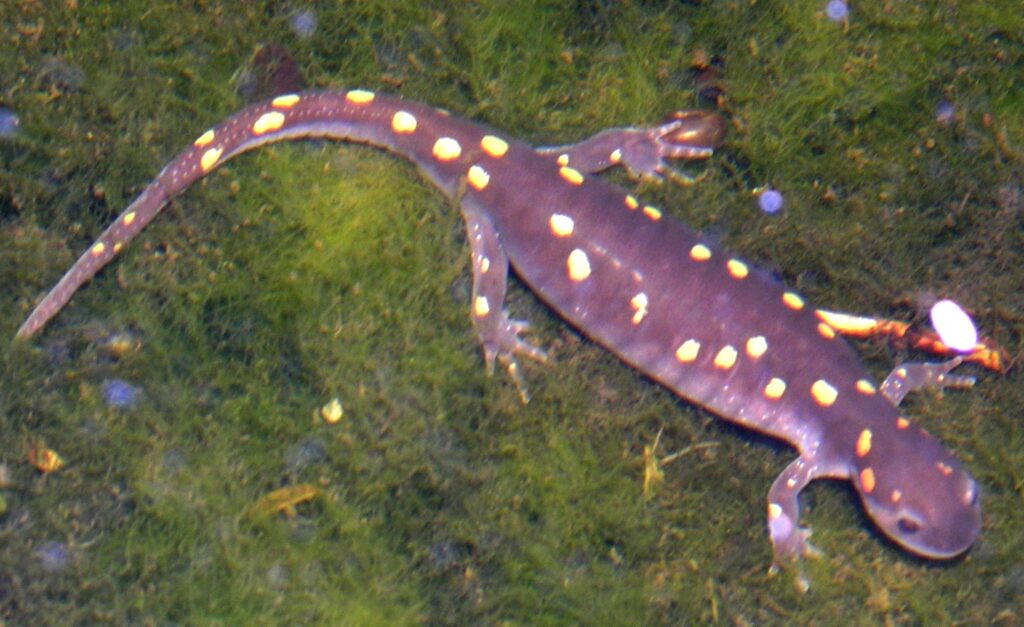Cryptic Plants on the Bark of a Red Oak Tree
By Roger Rittmaster
November 1, 2023
Have you ever looked, really looked, at the bark of a tree? Or at a moss-covered boulder in the woods? The cryptic world of small plants is fascinating and beautiful.
In this photo essay, we’ll dive deep into the bark of a Red Oak tree (Quercus rubra), looking at some of the plants that call this tree home. Although I’ll provide names for many of the species, what I really want to convey is the stunning beauty of the plants.
Red Oak is one of the more common trees in our Mid-Coast forest. The tree in this photo is near the side of a field in my backyard. What can grow on it is determined by the chemistry and structure of the bark, as well as the amount of moisture and sunlight that reaches the trunk.
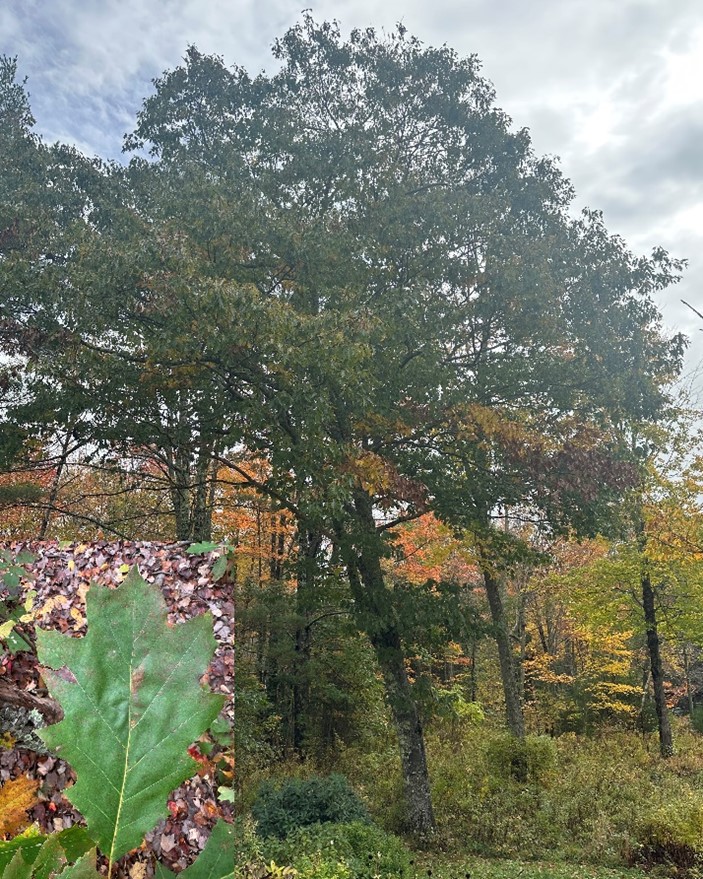

To do this exploration on your own, you’ll need a hand lens, also called a jeweler’s loupe. The ideal magnification is 10x – any more makes the lens more difficult to use. The word “Triplet” in the photo means that 3 lenses are combined to reduce distortion. Lenses such as these cost anywhere from about $13 to $40, and the less expensive ones are usually fine. Don’t get one with a light – the battery compartment is not sealed and corrodes easily. It’s also helpful to have a lanyard to carry the lens around your neck.
To use the hand lens, bring the lens close to your eye and bring your head close to the bark until the object comes into focus. It takes some practice, and a steady hand helps.
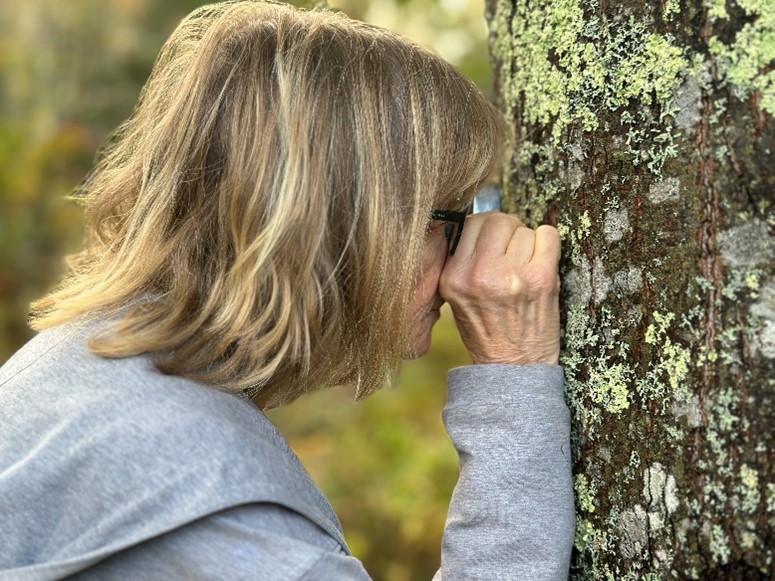
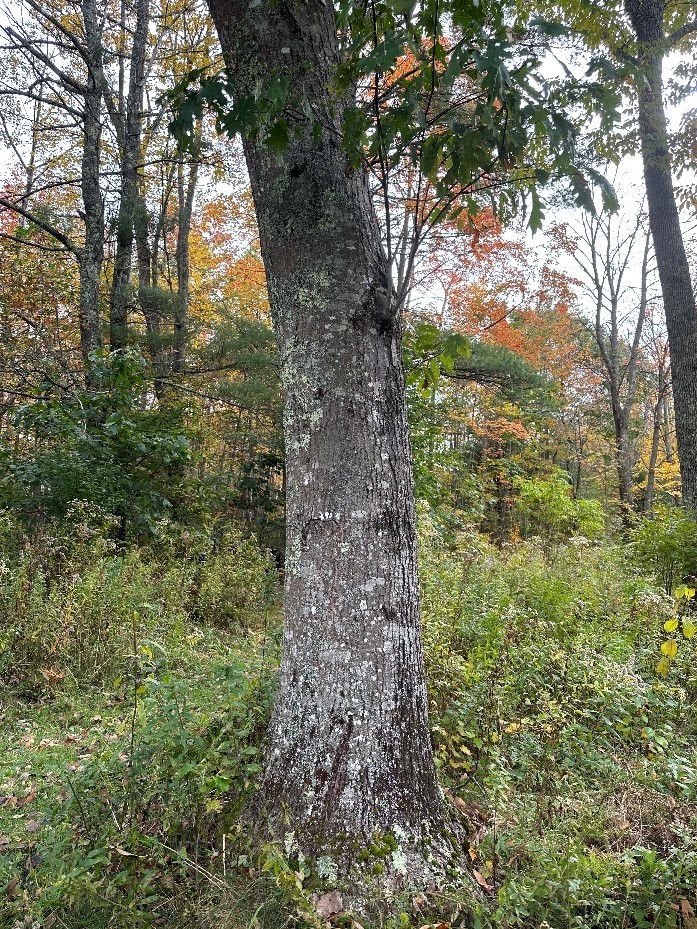
Even from a distance, one can see that the tree’s bark is covered with life.
As we move closer, the wide variety of plant life comes into focus. The red color is not bark. It’s clumps of green algae in the genus Trentepohlia. On this tree, it grows in the grooves of the bark, perhaps because that’s where the most moisture is. The individual strands are too small to be seen with a hand lens, and I wasn’t sure of its identification until I took a scraping from the bark and looked at it under a microscope (inset). The red color is from flavonoids, the same molecules that give leaves their yellow, orange, and red colors in the Fall. There’s so much flavonoid in Trentepohlia that it masks the green color of chlorophyll.
Trentepohlia can exist free as in this photo or symbiotically as the photosynthetic part of some lichens.
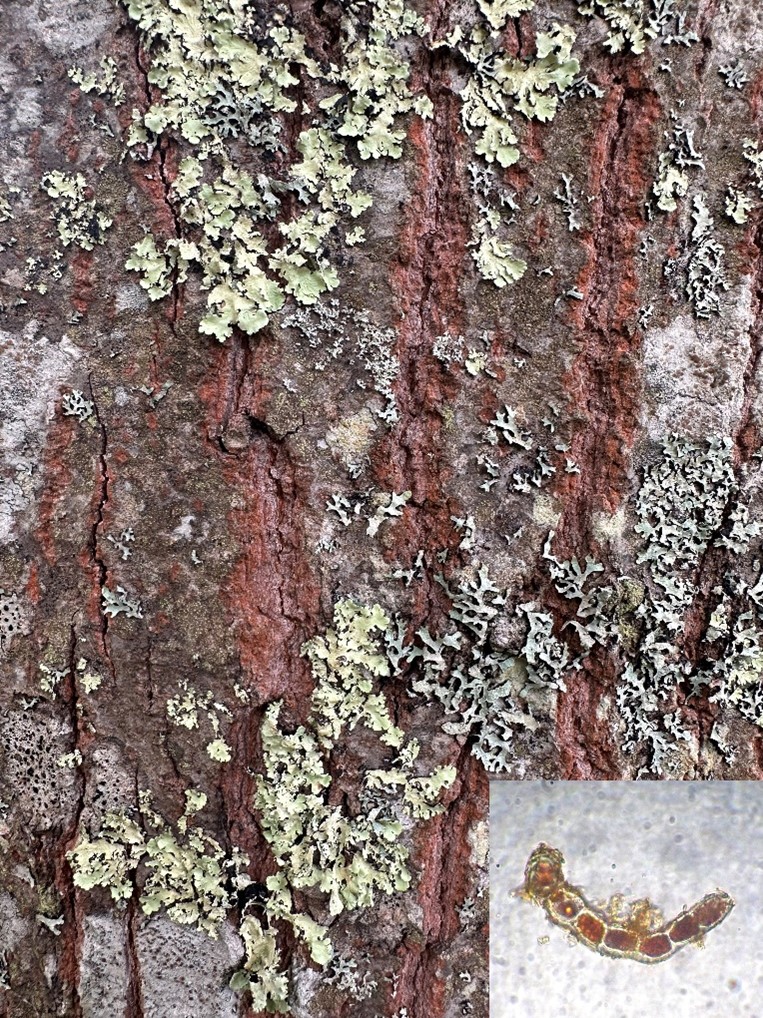
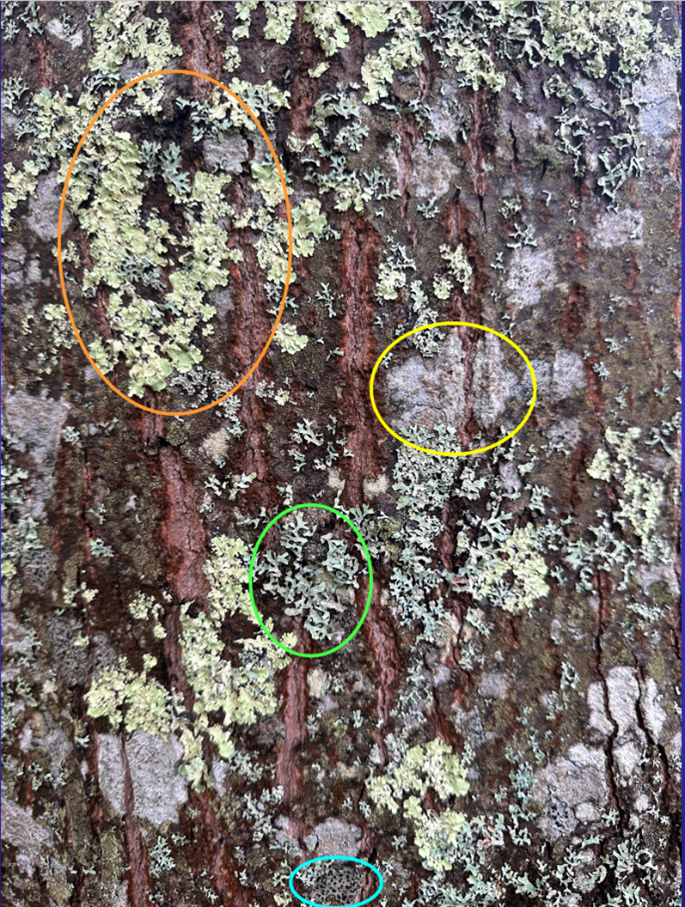
Much of what grows on the bark of Red Oak trees are lichens. Lichens are a combination of a fungus, which gives the lichen its structure, and algae, which provides sugars to the lichen by means of photosynthesis. This symbiosis is so successful that it has been adopted by hundreds of species of lichens in Maine.
Lichens are broadly divided into those that are foliose or leafy (orange and green circles), crustose or flat (yellow and blue circles) and fruiticose or upright (none on this tree’s trunk). The four lichens shown in this photograph can be identified at least to genus, but the species identification often requires a microscope.
The two foliose lichens look similar on first glance, but when shown side-by-side in the photo below, they are clearly different. The lichen on the right is Common Greenshield Lichen (Flavoparmelia caperata). The yellow-green color of this lichen is so distinctive, and the lichen so abundant, that one can recognize it at a distance, even driving by in a car. Looking at it up close with a hand lens, one can see that it has a generally smooth surface with scattered white granules called soridia (white arrow), located in the middle of the lobes, which can break off to form new lichens. The lichen on the left in the photo is called Shield Lichen (Parmelia sulcata). It has narrower lobes than Common Greenshield Lichen and is often cris-crossed by white breaks in the greenish-grey cortex (green arrow) called pseudocyphellae (Do scientists think that giving something a name that’s unpronounceable is a sign of intelligence?!). It can also have soridia, but when it does, they are often located on the edges of the lobes. One need not remember any of these distinctions to appreciate the intricacies and beauty of the lichens when seen through a hand lens.
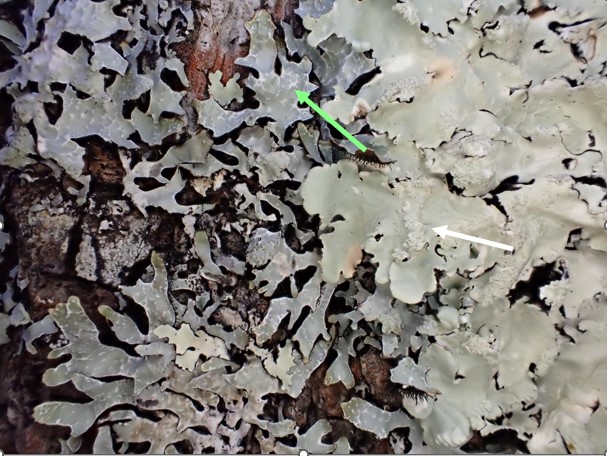
The difference between these two lichens is most dramatic when seen at night with an ultraviolet (UV) light. The photograph below on the left was taken with white light from a flashlight. Common Greenshield Lichen is on the left in each photo, and Shield Lichen is on the right. In the photograph on the right, UV light replaced the white light. Common Greenshield Lichen fluoresces dark brown, whereas Shield Lichen fluoresces orange.
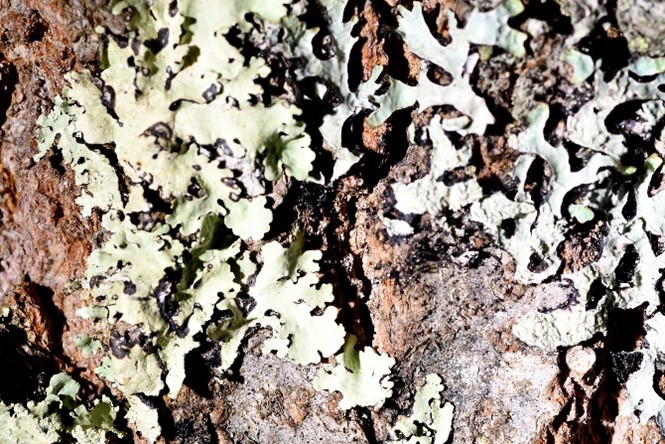
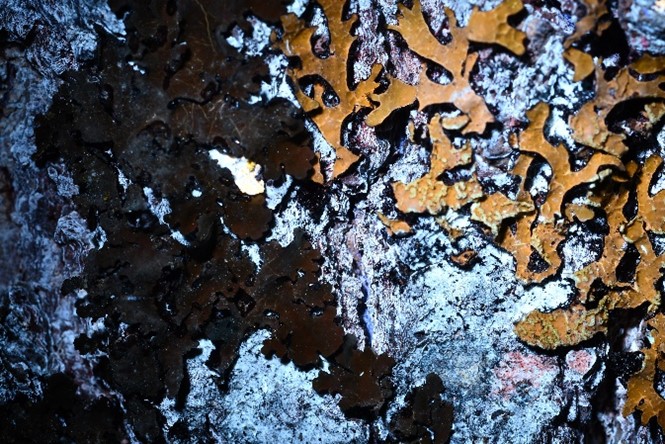
UV fluorescence occurs when UV light, which is invisible, is reflected back in a wavelength (color) that we can see. Lichens often contain compounds that either discourage herbivory (plants being eaten) or protect the lichen from sunlight damage. These compounds are thought to be responsible for UV fluorescence in lichens. If you ever want to get a neat gift to your favorite naturalist, give them a 365 nM UV light. They (and you) will be amazed at the amount of fluorescence in the plants around us. The term “365 nM” refers to the wavelength of the light being emitted by the flashlight. In trying to decipher what one sees with UV light, it helps to know that chlorophyll fluoresces red, and cellulose (a major component in grass) fluoresces blue. Yes, the grass in your lawn will look blue!
Now let’s look at two crustose lichens. Here’s a close-up of the lichen in the yellow circle in the earlier photo, most likely Bumpy Rim-Lichen (Lecanora hybocarpa). The white part of the lichen is called the thallus, and it is on, and embedded in, the bark of the tree. The red circles surrounded by a white ring (enlarged in inset at the lower right) are the fruiting bodies (apothecia). Inside the apothecia are sacs containing spores. The spores contain the fungal component of a lichen, and when they are released, they must find both a suitable substrate and an algae partner to form a new lichen. This is not as difficult as it may seem, because the algae cells can live on their own.
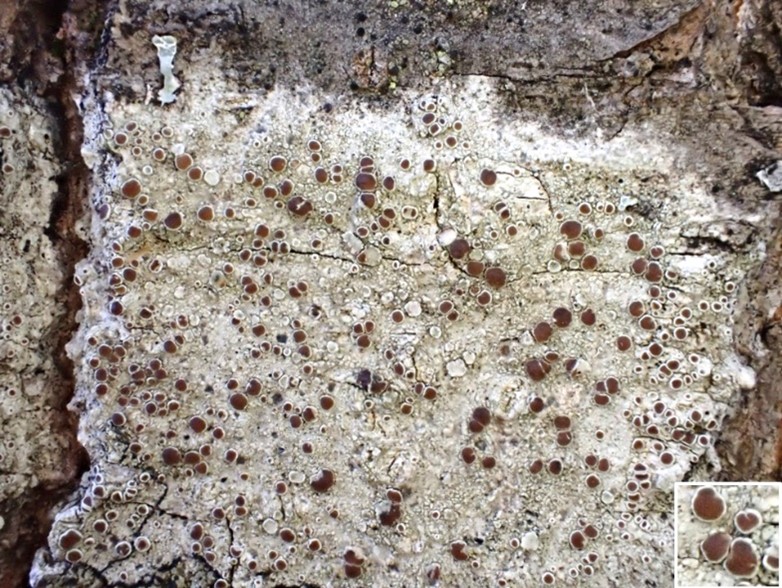
The other crustose lichen in the blue circle in the earlier photograph is shown below in white light (left) and with UV light (right). It in the genus Buellia, and its apothecia are all black. It is the only lichen I’ve seen that fluoresces purple. To identify the species of Buellia, I would need to measure the spores under a microscope and do a chemical test with potassium hydroxide. I suspect its fluorescence would also be diagnostic, although that’s not part of any key I know of.
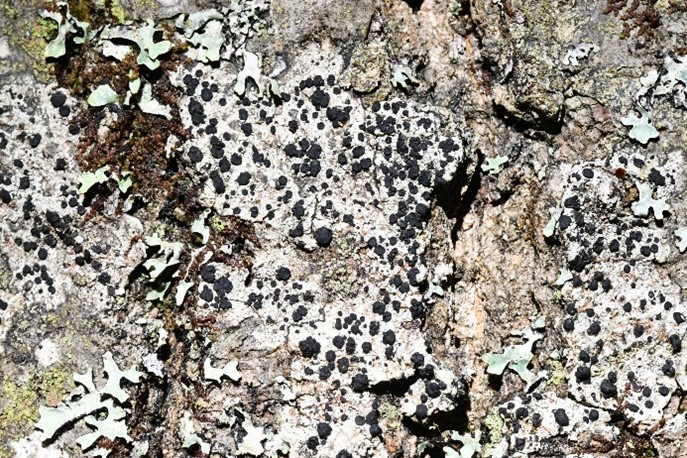
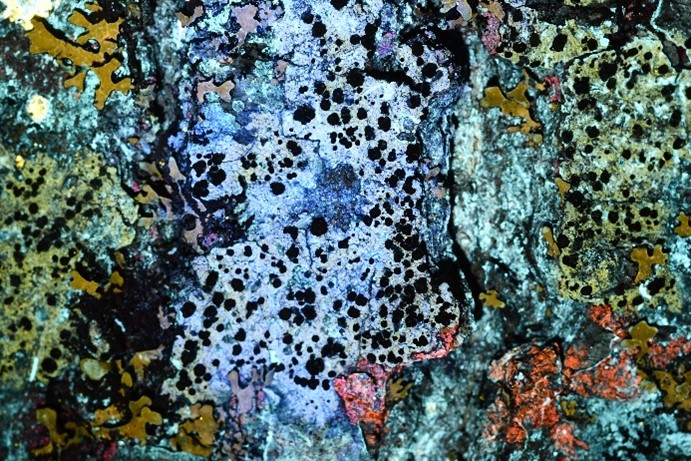
There are many other crustose lichens on the bark of this oak tree that one would normally overlook, even with a hand lens. In fact, the entire surface of the bark of the oak tree was covered, mostly with lichens. A typical small area is shown below in the left image. The 1 cm crustose lichen in the center lit up yellow under UV light (right image). I have no idea what species it is. Open book quiz: what’s the green foliose lichen on the left of the images that fluoresces orange?
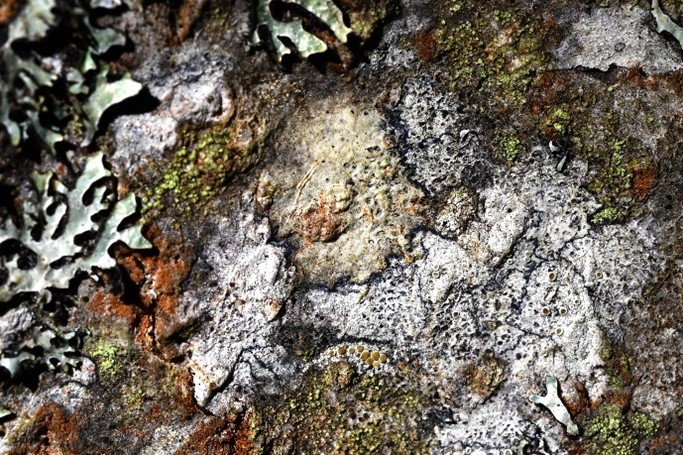
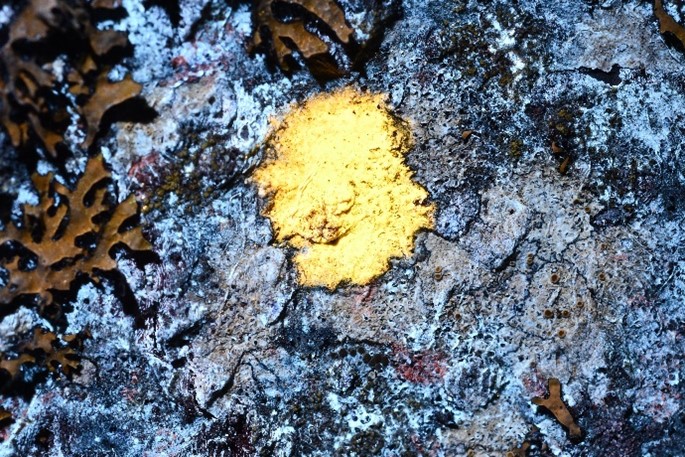
Mosses. Mosses are small, mostly green plants without a vascular system to transport water. They generally occur in moist environments, whereas tree bark is often dry. The mosses that grow on bark are often small and tucked away in crevasses. There is one moss that grows on both deciduous and evergreen tree bark and is easily identified: Ulota crispula (formerly Ulota crispa).
On this oak tree, it only occurred near the tree base, where there was more moisture. It grows in small mounds as in the photo on the right. When dry, the leaves curl up (“crisped”), hence the name crispula. The uncurled leaves can be seen near the top of the photo. The brown “spears” are immature sporophytes: the spore-bearing structures of mosses.
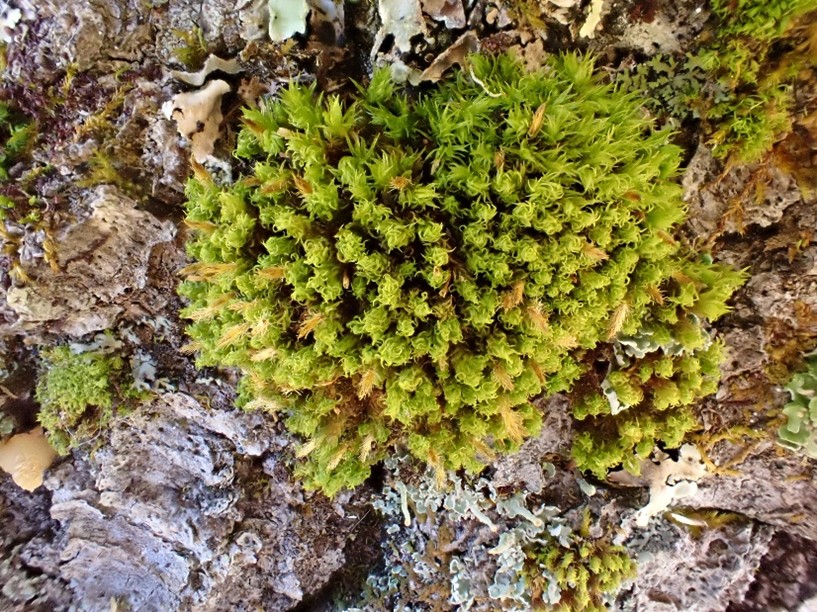
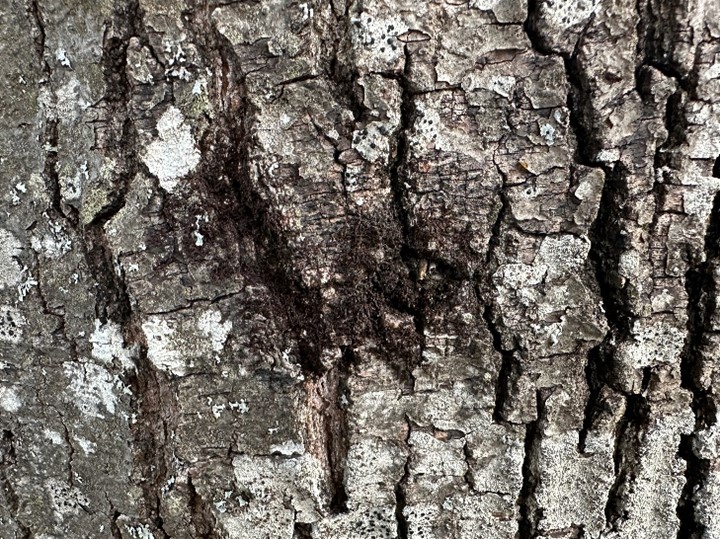
There is one other type of plant on the bark of the Red Oak that looks more like a brown (or reddish or greenish) smudge, until one gets close…
This is the common liverwort, Frullania, of which there are several species. The defining feature of liverworts is microscopic (single cell rhizines that hold the liverwort to the substrate), but Frullania is easy to recognize with a hand lens. It has tiny strands of leaves which become interwoven over time. The leaves are in two lines with a third line of leaves underneath. However, this liverwort is too small to easily visualize these lines with a hand lens.
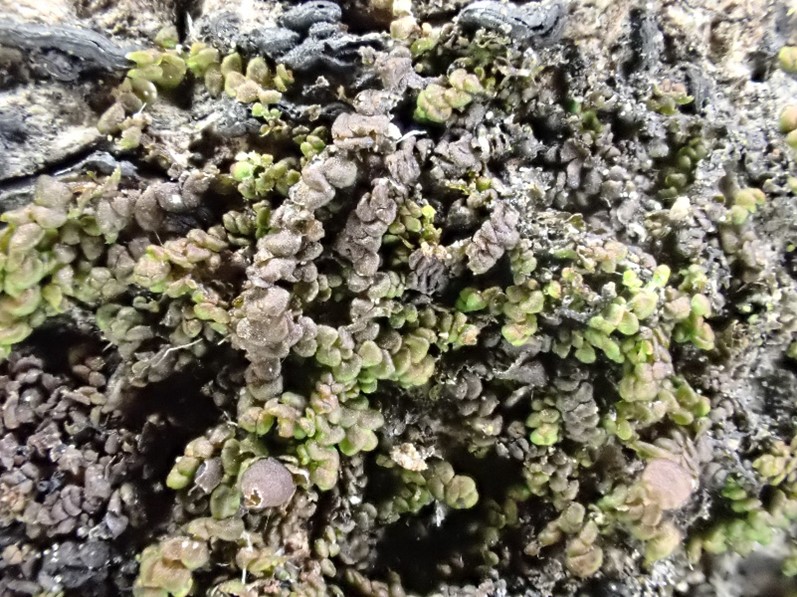
Fortunately for the reader, I have now approached the limits of my knowledge about the plants living on Red Oak bark. Hopefully, this photo essay will persuade some of you to take a hand lens and look closely at the beautiful world of tiny plants that surround us.
Past postings
Eagle Hill Institute – Maine’s Natural History Educational Gem
I could regale you with scores of mushroom photos but would rather tell you about this amazing place for natural history education that most Mainers don’t know exists.
An Appreciation of Autumn Leaves
Red maples are spectacular in the Fall, but if you want to see the most intense leaf colors in Midcoast Maine, visit a blueberry barren.
What’s That Bug? – Mimicry in the insect world
How do you tell a moth from a butterfly or a bee from a wasp? Lots of times it’s easy….
Wildflowers Living on the Edge in Newfoundland
Plants that can survive harsh environments.
August Wildflowers on Beech Hill
The ecological beauty of Beech Hill rests not only with its spectacular views of Penobscot Bay, but also with the diversity of habitats within the Preserve.
A Celebration of the Common Milkweed
Alright, the Common Milkweed is common, but how much more would we appreciate this wonderful plant if it was called “Pink-flowered Milkweed” or “Velvet-leaved Milkweed”?
Why Are Butterflies So Pretty?
The first couple weeks in July are the peak of adult butterfly diversity in Mid-coast Maine.
Beech Leaf Disease
A New Threat to the Ecological Health of Our Maine Woodlands
Dragonflies and Damselflies Are Back
(not that they were ever really gone)
Bird Song Identification with the Merlin App
Now is the time of peak songbird activity.
Spring Wildflowers on the Maiden Cliff Loop Trail – Mid May
Spring wildflowers on Camden’s Maiden Cliff Trail
Browntail Moth Caterpillars Emerging – Early May
What? You haven’t heard of the Browntail Moth?
Early Spring Wildflowers – Mid-April
Mid-April in Mid-Coast Maine is the start of spring wildflower season
Spring Peepers
The motto of this tiny frog should be, “it’s better to be heard than seen.”
The Spotted Salamander
Each Spring, Spotted Salamanders migrate from their subterranean forest homes to nearby vernal pools to mate.
